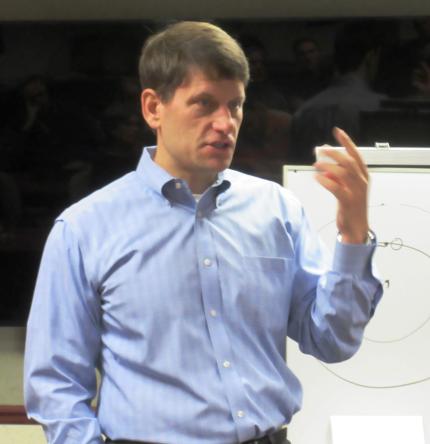Restorative Justice Allows Victims and Offenders to Meet

David LaGrand
Chris Meehan
Many prisoners he sees when he preaches in the Kent County Jail committed spur-of-the-moment crimes that they realize were wrong and for which they would apologize to their victims if they had the chance, says David LaGrand.
At the same time, many victims would appreciate the opportunity to sit down for a safe, mediated encounter with the person who committed a crime and be given an apology, said LaGrand, a CRC commissioned pastor who preaches on Sundays in the jail in Grand Rapids, Mich.
“Victims want some kind of restoration of peace. They want to know why someone did something to them,” said LaGrand in a presentation on the topic of restorative justice that was held recently at the Grand Rapids office of the CRC. His visit was sponsored by the Office of Social Justice.
LaGrand, a former prosecutor who works as a criminal defence attorney, has been involved for many years in trying to bring restorative justice to area schools and would like to see it used in the criminal justice system.
“Restorative justice, which started in the Mennonite community about 40 years ago, is a Christian vision for how we ought to deal with conflict,” he said.
In its report on restorative justice, Synod of 2005 called churches to preach and teach restorative justice as a biblical perspective and to apply the principles of restorative justice to the problems of crime in communities and countries, said Kate Kooyman, the CRC’s restorative justice coordinator.
"Restorative justice treats the victims of crime with dignity — assuming they have needs, and a voice, and the possibility of seeking healing and wholeness,” she said.
“It also treats those who have committed crimes with dignity — assuming they can take responsibility, they can feel empathy, and that they are expected to help heal the harm caused.”
Canada, England, Australia, New Zealand and Japan are among the countries that have restorative justice programs in which offenders and victims can interact during the criminal justice process, said LaGrand.
Several of these countries have found that over time offenders who have undergone restorative justice practices are not as apt to return to prison, while the victims feel less traumatized, he said.
The U.S. system basically leaves the victims out of the equation, which in turn prevents any type of restoration to occur between the victim and the person who committed a crime, said LaGrand.
“The U.S. government has a monopoly on how to deal with these things we call conflicts,” he said. “When there is a crime, it is seen as a breach of the government’s peace.”
The government takes the criminal to court, leaving the victim to play a marginal role, if any at all, as the case unfolds and a criminal is convicted and sent to jail.
Although this system tended to work over time, it began breaking down in recent decades, said LaGrand, as the government has undertaken a “stunning” policy of mass incarceration of young black men, the poor, the mentally ill and people with substance abuse problems.
“More people are being incarcerated today, some 2.2 million people, than there are farmers in this country,” said LaGrand. “This nation keeps making tougher laws to supposedly help people.”
There is a growing conversation in the U.S., including among the Democratic and Republican candidates for president, about the issue of mass incarceration and the need for criminal justice reform.
But there remain practical considerations for keeping the current system in place, said LaGrand.
On the one hand, there is a “large prison industrial complex” that pays the salaries of thousands of criminal justice workers, from attorneys to judges to prison guards, as well as provides economic resources to communities in which prisons are located.
In addition, there remains the widespread belief that punishing people for their crime — and not finding ways to restore them -- is the best answer, said LaGrand.
As a Christian, he said, he finds this idea “morally appalling and repugnant … Prison makes monsters out of people. People are isolated and constantly exposed to threats.
“We have a penal system that keeps doing the same thing and expecting different results.”
People come out of prison with few skills and full of anger. If they have a felony on their record, the law prohibits them from even finding a job, said LaGrand.
“It is a huge problem. Not only have they been locked up, but they are handicapped and stigmatized when they get out by having a criminal conviction,” he said.
Important to keep in mind, added LaGrand, is that restorative justice — when it is available — isn’t always the answer to helping prisoners.
Some crimes such as domestic violence are not great fits for this. “Not all victims want an encounter with an offender,” he said.
But overall, he said, the idea of addressing the restoration of the lives of victims and offenders has great promise — if only the U.S. criminal justice system would support it more strongly.
“What we have now is tragic. It’s crazy,” said LaGrand. “Criminals aren’t aliens. They are people like us. They have the same feelings and reactions.
“On the other hand, most victims want to talk to the offender. They don’t want to be hermetically sealed away.”


